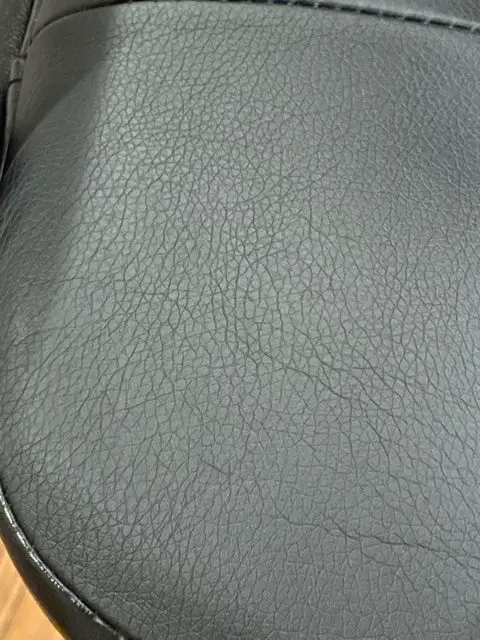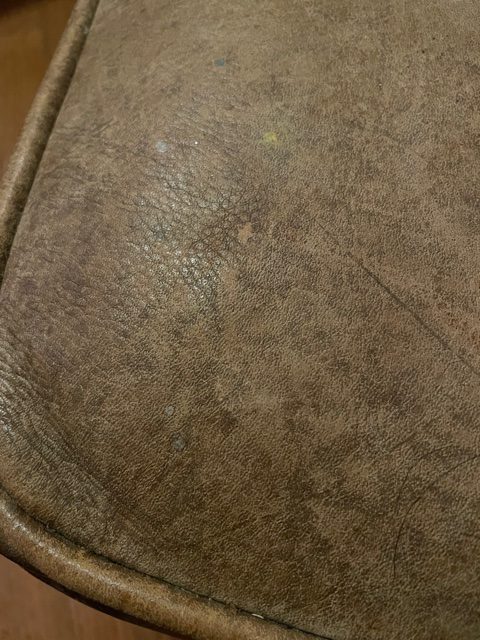With the advent of new innovations in the furniture space, it can be challenging for a consumer to tell the difference between a real leather sofa and some of the newer faux or vegan leather couches on the market.
And often, some manufacturers are not upfront with materials used to make a leather sofa, intentionally masking the true materials used to design their furniture, while advertising it as 'genuine leather'.
So, how to tell if a couch is real leather? And not some faux, man-made material?
Real leather should feel smooth when you touch it and stretch like skin - let's not forget this is the hide of an animal we are dealing with!
Real leather also has a distinct smell, whereas fake leather has a chemical, plastic-oriented smell.
Lastly, inspect the furniture to look for imperfections (a sign of real leather) and not perfect patterns of grain, which indicate a sofa using fake, man-made materials.
Everybody knows that leather is a durable and luxurious material. However, you can't always tell if the furniture is real leather just by looking at it.
There are many different ways to test the authenticity of a piece of furniture's leather material.
In this post, we dive further into how you can identify fake or real leather couches or other pieces of furniture in your home.
Now, one quick aside is that leather types make a world of difference!
There is a vast difference between FULL grain cowhide and what is known as "genuine leather".
As a consumer, you want to focus on TOP Grain leathers (Full Top Grain Leather and Top Grain leathers). This is the best leather quality you can buy.
Moving down in terms of leather grades, you next get to Split Leathers, a very low quality leather. Also often known as "Genuine Leather" or Bicast Leather (sometimes also referred to as Bycast) and combine the leftover 'splits' of the cowhide and, in some cases, use a combination of leather and cheap plastic materials.
Bonded Leathers are even worse and made from leather scraps, in combination with polyurethane to create a leather-like material, sometimes known as reconstituted leather or blended leather.
It is more like the 'particle board of the leather world,' as one leather expert has called it.
One word for Bonded leathers - AVOID.
Lastly, 'Faux' Leather is entirely synthetic and made from PVC and other chemical compounds.
The manufacturers of low-price, mass-leather furniture are VERY GOOD at marketing these HORRIBLE leather imitators with very misleading terminology.
We recommend TOP Grain leathers when purchasing a new leather sofa and especially avoid any Bonded or Faux Leather sofas.
One key thing I should mention is that you NEED to analyze the materials from the retailer if considering any furniture purchase.
Most reputable retailers are going to provide everything we need to make an intelligent decision.
The lingo, however, is going to differ wildly from store to store.
You might see Full Grain Leather, Top Grain Leather, and Full Top Grain leather, and ultimately, if you see any of those mentioned, it's probably the case that the leather used is relatively high quality.
If they are using an artificial leather alternative or even a 'vegan leather,' it will be pretty apparent from the label on the furniture.
Vegan leathers are made from synthetic materials that will not withstand wear and tear like a real leather sofa.
If we have done our homework reading the label, we should have a better idea of what sort of materials our furniture is made from.
Let's return to how we tell the difference between a real and fake leather couch.
How To Tell If A Couch Is Real Leather or Faux Leather?
Here are five ways to test whether a natural leather sofa is real or not.
1. Smell The Leather
A Real Leather Sofa Has An Indistinguishable Smell
Leather is a material used for thousands of years, and its smell can be considered one of its best qualities.
Leather emits a highly distinct smell that many people consider pleasant or arousing.
Thus, one of the most well-known ways of identifying a real leather sofa is via the scent, which can linger even after years of ownership.
I have heard, however, that some manufacturers will spray their furniture with artificial scents that mimic the smell of real leather, so beware of something using an artificial fragrance.
Ultimately, if your nose is good, you will likely pick up the artificial smells used in fake leather sofas that consist of man-made materials and, in many cases, different forms of plastic.
2. Burn The Leather (Use With Caution)
I've heard a matchstick is another method used to determine the legitimacy of a faux leather sofa.
When lit up against the item in question, it is likely made of artificial materials and not real leather if the material starts to catch fire.
I haven't yet conducted this test, but here is an old video discussing this fact.
However, it all makes a lot of sense to me since plastics will burn, and most fake or synthetic leather is made from polyurethane, a flammable material.
I'd be wary of doing this however in your local furniture store!
3. Feel The Leather
A Real Leather Sofa Is Soft, And Real Hides Are Easily Identifiable
A sofa in a showroom might be tough to asses for those without leather experience.
However, leather is easily distinguishable from faux leather based on the hide's backside.
Now, you can't see a leather hide on a finished leather sofa, but the showroom can most likely show you a sample.
This is a pretty good video: a consumer bought a bonded leather sofa that peeled like crazy, something quite familiar with junk bonded leather sofas.
The back of the leather should have a rougher, grainy, suede-like feel, and don't forget that this is the hide from a cow.
A fake faux leather product will have a smooth, man-made backing to it. You could ultimately inspect the back of the leather on the cushions if they also unzip.
4. Examine The Leather Grains
Real leather comes from the hide of a real animal; in most cases, especially for leather sofas, it is from a cow.
Thus, when we think about the hide of a cow, these naturally have an irregular texture, often with many imperfections such as scars or bug bites. This is especially the case with aniline full grain leather sofas.
With bonded or faux leathers, the manufacturers will stamp or emboss a grain pattern into the material in question to try and recreate the grain on authentic cowhide leather.
This embossing tends to come across as 'too perfect' and is easily distinguishable in most cases from a real leather sofa.
Here's a bonded faux leather office chair made with an artificial or embossed grain.
Hopefully, you can see that this is an outer surface grain look that has been applied and is not inherent in the material of what might be a genuine hide.

And here's a real full-grain leather ottoman, where we can see more AUTHENTIC imperfections and marks, indicating that it would certainly be a real leather piece.
Note my kids have also made quite a few spills on this piece, and little damage has been done.

This is also a good video that discusses bonded leather. I can guarantee you probably have something in your home made of bonded leather in your home!
5. Check the Label And Price
A genuine leather item often comes with a label that indicates it is genuine. Look for terms such as “100% Genuine Leather”, “Full Grain” or “Top Grain Leather”.
It’s important to know that not all leather is created equal. There are different grades of leather, and many manufacturers will try and use confusing terminology to confuse buyers.
In addition, the price point for a sofa can usually help distinguish whether or not the sofa in question is real or faux leather.
A full or top grain leather sofa has a starting point typically at around $3,000 and moves higher from there, based on leather type, build quality and brand premium. If your sofa is selling for $2000 or under, it makes sense to ask more questions of the salesperson as to what you are buying.
It can be hard to tell the difference between top grain leather and more inferior bonded or even faux leather products.
Knowing how to tell if a leather couch is real or not can certainly make you an informed consumer and make an intelligent purchase decision for your home or office space.
I hope this post was helpful and that it leads to you avoiding some of the terrible products that exist on the market!
If you have any questions about this blog post, please email me at tom@bestleathercouches.com

